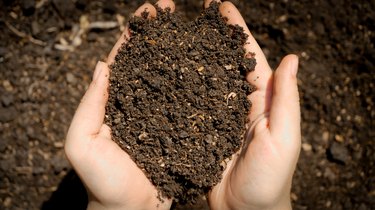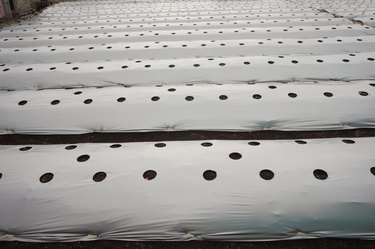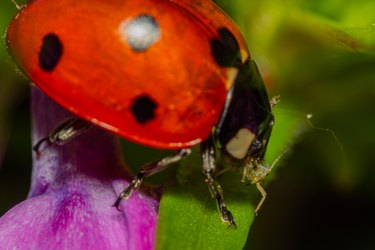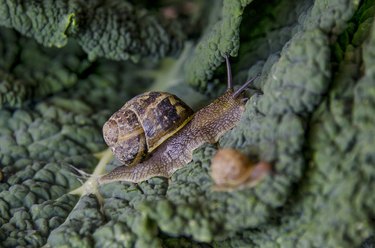The flowers, vegetables or landscape plants you're growing may be just as attractive to certain garden pests as they are to you. You may be willing to accept a certain threshold of damage, such as a few chewed leaves or flowers, before reaching for an insecticide. However, when garden pests leave your plants in tatters from their heavy feeding, you may not be so inclined to look the other way and leave these creatures unchecked.
Responsible gardeners know the importance of judiciously using pesticides because of their potential chemical harm to beneficial insects – the good guys who don't harm your plants – as well as potential adverse effects that many chemicals have on the environment. As a beginning gardener, you may be surprised to learn that there are other ways to manage plant pests than by simply dousing them with synthetic chemicals. It all starts with three important letters: IPM.
Video of the Day
Video of the Day

Integrated Pest Management
Integrated pest management (IPM) is an environmentally responsible approach that gardeners can take to manage plant pests (as well as diseases and weeds). IPM is a multipronged strategy that advocates beginning with the least toxic methods for pest control and gradually incorporating stronger control methods until pests are acceptably managed. However, you'll want to be able to differentiate between what you perceive as a pest and a beneficial insect that feeds on pests.
For example, almost everyone knows that lady beetles (ladybugs) are beneficial insects, but their larval stage looks nothing like the cute, identifiable, spotted adult beetles. Ladybug larvae look a little menacing, almost like tiny alligators crawling on plant leaves. They're worth their weight in garden gold because of the numbers of aphids they eat, just like the adult beetles. So, if you spray an insecticide on these larvae, you'll not only be killing these voracious aphid-eaters but you'll also be preventing the larvae from developing into adult ladybugs.
As a beginning gardener, use the following four methods to take an IPM approach to controlling the pests in your garden. You may only need to use one method before you see results, but you may need to incorporate multiple methods for successful pest management.

Cultural Pest Control Methods
Start with healthy soil. A basic principle in organic gardening is that healthy soil supports healthy plants, and when plants are healthy, they're better able to withstand the onslaught of many types of insect pests. Incorporating compost and other organic matter into the soil offers multiple benefits, including improving soil texture and promoting drainage.
The rhizosphere is the area in the soil around plant roots, which is where microbes break down organic matter into usable nutrition that plants absorb through their root systems. You can even add something called mycorrhizae to the soil to boost healthy roots. Named from "myco" (fungus) and "rhiza" (root), mycorrhizae are beneficial fungi that grow on and around roots to increase the water and nutrient absorption capacity for the host plant.

Mechanical and Physical Pest Control Methods
Mechanical and physical pest controls use devices or objects to control pests. Floating row covers keep certain insects away from plants while allowing sunlight and water to reach the plants. You can also use plastic mulch or even landscape fabric instead of organic mulch as a barrier for insects that overwinter in the soil. These methods let water and nutrients reach plant roots, but they help keep insects from burrowing or laying eggs in the soil.
Many pests, such as aphids, can be managed by perhaps the least toxic method of all – water, which is actually categorized as a mechanical IPM practice. By simply directing a stream of water from your garden hose or handheld sprayer, you can dislodge aphids from your plants. Surprisingly, most of the aphids will be unable to crawl back onto your plants. For the few that do, another stream of water will knock them off again.

Biological Pest Control Methods
Biological pest control methods employ living organisms to control pests. Ladybugs and lacewings feed on insect pests, such as aphids, and you can even purchase these predators for release into your garden. Once released, however, they'll only stay in the landscape if aphid populations are high enough; otherwise, they'll simply fly away. So, purchasing lady beetles or lacewings may not be cost-effective for the average landscape. A better strategy is to have diversity in the plant species that you're growing, which will naturally attract beneficial insects to control pests.
Certain bacteria (Bacillus thuringiensis), commonly called Bt, can be employed to kill many types of insect larvae. These bacteria are classified into different strains, with each strain controlling different types of caterpillars. For example, Bt (kurstaki strain) is toxic to many types of caterpillars that feed on leaves and needles, and Bt (tenebrionis strain) kills the larvae of elm leaf beetles.

Chemical Pest Control Methods
Many people cringe at the word "chemical" when referring to insecticidal use in the garden, but even plants produce chemicals, called phytochemicals (phyto = plant). There are certainly organic chemicals, including water and oxygen, that are essential to plant growth. In the context of organic gardening, "chemical" controls generally mean those derived from synthetic sources, and "organic" controls generally mean those derived from a plant or animal source.
Gardeners must take care not to read "safe" into "organic pest control," however, because any pesticide, whether organic or synthetic, may be harmful to plants, people, pets and the environment if used improperly. Broadly speaking, organic insecticides have little to no residual footprint, which gives them a thumbs-up among organic gardeners.
Neem oil, which is extracted from the neem tree, is approved as an organic chemical control to combat more than 200 plant pests. When sprinkled around plants, food-grade diatomaceous earth (DE) works wonders to control slugs. Approved as an organic pest control, DE is more correctly categorized as a mechanical control because it kills by slicing into soft-bodied insects and mollusks, such as slugs and snails, as they crawl across it. You'll see it in the same location in garden centers where you'll find other chemical insecticides.